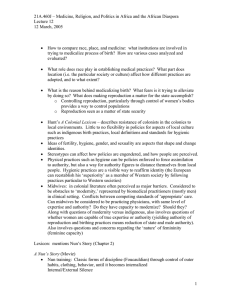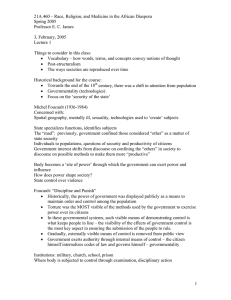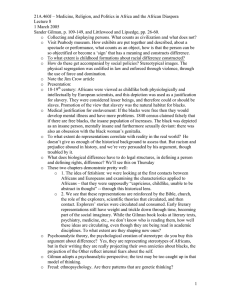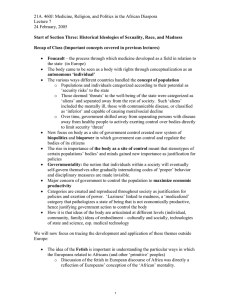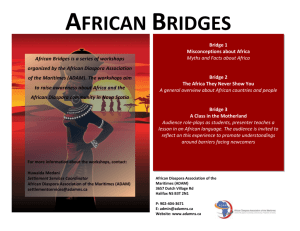21A.460 – Medicine, Religion, and Politics in Africa and the... May 5, 2005 Discussion of Reading
advertisement
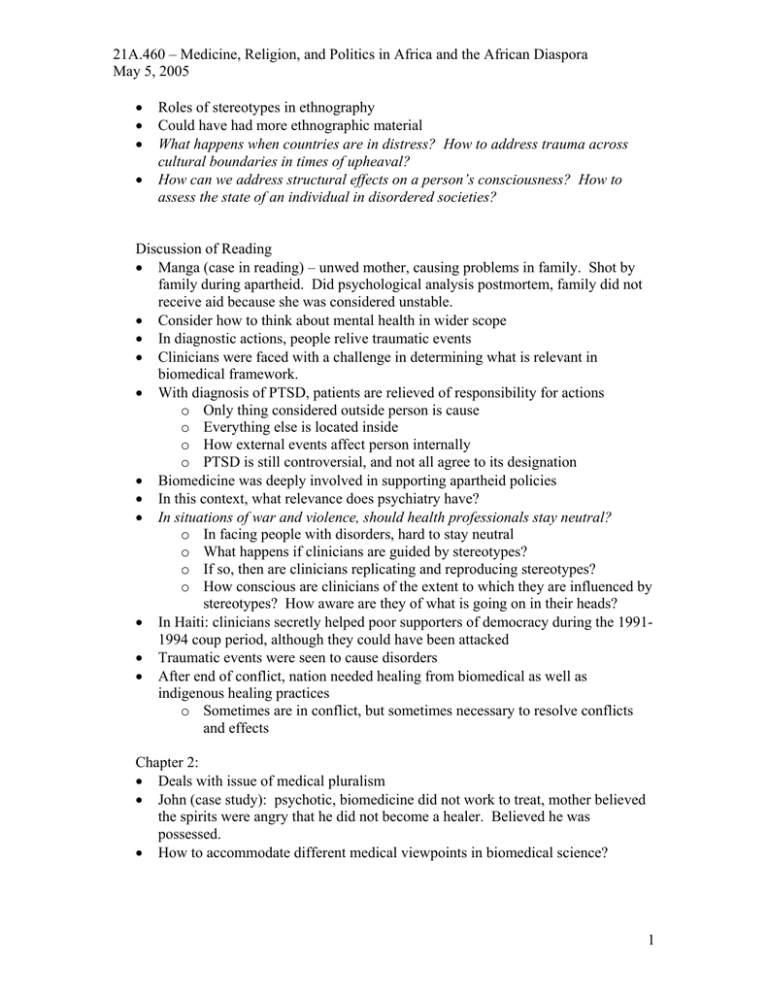
21A.460 – Medicine, Religion, and Politics in Africa and the African Diaspora May 5, 2005 • • • • Roles of stereotypes in ethnography Could have had more ethnographic material What happens when countries are in distress? How to address trauma across cultural boundaries in times of upheaval? How can we address structural effects on a person’s consciousness? How to assess the state of an individual in disordered societies? Discussion of Reading • Manga (case in reading) – unwed mother, causing problems in family. Shot by family during apartheid. Did psychological analysis postmortem, family did not receive aid because she was considered unstable. • Consider how to think about mental health in wider scope • In diagnostic actions, people relive traumatic events • Clinicians were faced with a challenge in determining what is relevant in biomedical framework. • With diagnosis of PTSD, patients are relieved of responsibility for actions o Only thing considered outside person is cause o Everything else is located inside o How external events affect person internally o PTSD is still controversial, and not all agree to its designation • Biomedicine was deeply involved in supporting apartheid policies • In this context, what relevance does psychiatry have? • In situations of war and violence, should health professionals stay neutral? o In facing people with disorders, hard to stay neutral o What happens if clinicians are guided by stereotypes? o If so, then are clinicians replicating and reproducing stereotypes? o How conscious are clinicians of the extent to which they are influenced by stereotypes? How aware are they of what is going on in their heads? • In Haiti: clinicians secretly helped poor supporters of democracy during the 19911994 coup period, although they could have been attacked • Traumatic events were seen to cause disorders • After end of conflict, nation needed healing from biomedical as well as indigenous healing practices o Sometimes are in conflict, but sometimes necessary to resolve conflicts and effects Chapter 2: • Deals with issue of medical pluralism • John (case study): psychotic, biomedicine did not work to treat, mother believed the spirits were angry that he did not become a healer. Believed he was possessed. • How to accommodate different medical viewpoints in biomedical science? 1 21A.460 – Medicine, Religion, and Politics in Africa and the African Diaspora May 5, 2005 • None of the health officials used mom’s knowledge about situation. Why wasn’t the mother’s expertise about the situation used in determining the problem and treatment? • Cross-cultural look at schizophrenia: o 2 different studies o Developing countries have more cases than developed (why?) o Unsure whether it is from bias in definitions of schizophrenia, or actually that there are more cases o Quicker onset in developing countries o Outcomes are better in developing countries o In developing world, people can be mentally ill and still be productive and fulfill social role, which can control course of illness. o Role of economy in mental illness o Easier to get back into society in the long-term in developing world • Schwartz wants more ethnographic experience, more lived experience rooted in certain ideologies o Lived experience can give more knowledge about patterns of social suffering o Lack of knowledge about the ‘Other’ in clinical settings can reinforce notions of status quo unconsciously, reinforce common notions of ‘normal’ and ‘Other’ Chapter 10 • Transient psychoses. Psychosis and possession states often similar. How to determine difference, treat? • Biological and psychosocial interlinked, can’t separate. • There are other influences that make possession/psychosis difficult to study. For example, difficult in situations where alcohol or drugs are used • Transient disorders, dissociation, on larger scale are linked to ‘primitive’ societies • ‘Modern’ world also causes fragmentation of mind o Multiple personalities increasingly common o Becoming a first-world disease o This is becoming a convergence point between 1st and 3rd world o To what extent do clinicians want to pathologize these experiences? Should it these be considered on a continuum between socially acceptable and pathological, rather than strict discrete units of separation? • Explores how certain behaviors are seen as pathological • African/African-American men in developed settings are diagnosed with schizophrenia in much greater numbers than in any other racial group • There are more complex ways to engage these issues that are not rooted in Western context • Questions notion of the autonomous individual. Is this a valid model? • Flexible self and boundaries between individual and environment/social world are malleable 2 21A.460 – Medicine, Religion, and Politics in Africa and the African Diaspora May 5, 2005 • • • Schwartz can point out similarities to Western model, but still recalls questions of power, since Western world still defines notions of person, normal, and pathological Western world still holds power to construct knowledge about other Malleability of person – described in O.Butler book (to be read next week) Movie: The Return of Sara Baartman • Georges Cuvier: French scientist who dissected Saartje Baartman (Hottentot Venus). o Baartman’s callipygean character likened to monkeys. o Physiognomy repeatedly likened to orangutans. • Baartman elevated French and medicine: she became part of French medical heritage • She was a symbol of black women’s sexuality. • Represented missing link to many people. She was used to establish link between animal kingdom and human. • Her skeleton remained on public display until 1967. • Brain size same as Descartes, establishing that brain size cannot be used as a marker for intelligence, etc. • Ironically, she was born in 1789, the same year that supposedly marked the end of sexism, racism, and restored respect for women in France • After years of negotiation, French government gave up her remains. • Her remains were taken to South Africa, buried on South Africa’s day of women • Issues brought up in transferring her, determining her burial site and historical memorial: o Who has the right to speak for her? Tribe? Country? o Why can decide for her? o Issue in using her tissue for experiments a considered a matter of informed consent o Giving respect: one aspect of paying respects to her can be seen as a political act – her suffering is focal point and outlet for collective social suffering. 3 MIT OpenCourseWare http://ocw.mit.edu 21A.460J / WGS.620J Medicine, Religion and Politics in Africa and the African Diaspora Spring 2005 For information about citing these materials or our Terms of Use, visit: http://ocw.mit.edu/terms.
